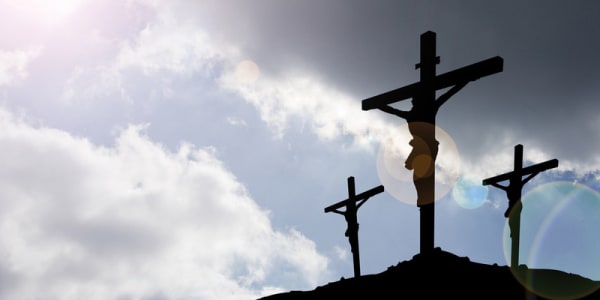Learn more about ActiveChristianity, or explore our theme pages for more
The three crosses on Calvary: What do they signify?
Three men were crucified on Good Friday. Who were they?

Three crosses – three different men
There were three crosses on Calvary on the day Jesus Christ was crucified.
“And when they had come to the place called Calvary [the Place of a Skull] there they crucified him, and the criminals, one on the right hand and the other on the left.” Luke 23:33.
It was not by accident that Jesus was crucified with two thieves. Isaiah had prophesied: “Therefore I will divide Him a portion with the great, and He shall divide the spoil with the strong, because He poured out His soul unto death, and He was numbered with the transgressors, and He bore the sin of many, and made intercession for the transgressors.” Isaiah 53:12.
Like what you’re reading?
The first man
“Then one of the criminals who were hanged blasphemed Him, saying, ‘If You are the Christ [Messiah], save Yourself and us.’” Luke 23:39.
This robber represents the world that wants to be saved without acknowledging the judgment: If You are the Messiah, then take away the judgment; let us escape and You with us. Show us what You can do. If you are a Christian, then you must please me and satisfy my demands. If You are the Messiah, then go up to Jerusalem for the feast and show Yourself to the people; cast Yourself down from the temple's pinnacle and command stones to become bread. Display Your glory and Your talents so that people can truly see and understand that the Messiah is among us. This is the kind of Messiah the world desires, and one day their desire will be fulfilled in the Antichrist.
However, Christ's mission was not to let the world escape judgment or to perform signs and miracles in the presence of the beast and earn its approval. He came to crucify the world and to bring it into death, so that everyone who dies with Him might receive life.
The thief was hanging on the cross. He could blaspheme all he wanted, but he was condemned to death, and the nails of the cross firmly held their prey. In this same way, the world is also crucified, because we reckon that if one is crucified for all, then we are all crucified; and if one died for all, then we are all dead. The Spirit brings convictions about the judgment that is to come, because the prince of this world has been judged. These convictions are the nails which an ungodly person can never tear out of his heart. The world can try – as the thief did – to save its life, but it will not succeed; it will lose it.
The second man
“But the other, answering, rebuked him, saying, ‘Do you not even fear God, seeing you are under the same condemnation? And we indeed justly, for we receive the due reward of our deeds; but this Man has done nothing wrong.’” Luke 23:40-41.
The first thief wanted to be saved without judgment. The second thief, however, was willing to suffer for the evil deeds he had done according to the flesh so he could be freed from them in eternity. He put his burden of sin on Him who bore the sins of the whole world, and he received the assurance that he would be with Jesus in Paradise.
The first thief had sin in him and resting over him, and it was the same with the second thief. However, the latter was freed from his burden of sin through acknowledgment and judgment. There was no more condemnation for him. He was cleansed from what he had judged in himself. Nevertheless, he did not get rid of his indwelling sin. He represents the people who are cleansed from their sins but have no desire for anything more.
The third man
This was none other than Jesus Himself. The first thief directed his mockery at Him, but He did not reply; the other thief replied for Him. Today, too, God has saved thieves who can answer all the world's questions about Jesus and refute their arguments and turn aside their mockery. Jesus, however, does not answer them a single word. But He does answer the second thief with an oath: “Assuredly, I say to you, today you will be with Me in Paradise.” Luke 23:43.
Jesus not only took our sins on His body up on the tree, He also bore sin in His body. He was made sin for us. God condemned sin in His flesh. (Romans 8:3.) When this work was finished, He gave up His spirit. It was impossible for the law to judge sin in the flesh, because all the sin that is committed by a man is outside the body. However, now God did what was impossible for the law: He condemned sin in Christ's flesh. Everyone who now wants to be saved from indwelling sin must take up his own cross daily. The thief was saved from his transgressions, but he did not become a partaker of divine nature. Jesus did not have the nature of angels; He was of the seed of Abraham. (Hebrews 2:14-18.) This was so that He could destroy sin in the body and in its place plant the fullness of the Godhead, which now dwells in Him bodily.
There is no condemnation for the judgment that takes place in the body over sin in our nature, because it takes place within the body. However, Peter writes about this salvation, “If the righteous one is scarcely [with difficulty] saved …” 1 Peter 4:18. There is a growth of the body, a salvation of the body and a judgment of the body, so that everyone will be rewarded according to what he has done with his body.
God does everything double. He provides an outward salvation through Jesus Christ. He provides an outward and an inward salvation through the same Person. However, the enemies of the cross of Christ are opposed to this inner salvation, and like the thief, they are satisfied with the forgiveness of sins.
This is not so with the bride of Christ. She wants to be a partaker of His holiness and has counted the cost. She is flesh of His flesh and bone of His bone. She is willing not only to share the joy with her Bridegroom, but also to suffer and die with Him – not only die to the curse of the law, but die to the nature of Adam in the body.
This article has been translated from Norwegian and was first published under the title “Three Men Crucified” in the periodical Skjulte Skatter (Hidden Treasures) in April 1914.
© Copyright Stiftelsen Skjulte Skatters Forlag | ActiveChristianity
Scripture taken from the New King James Version®, unless otherwise specified. Copyright © 1982 by Thomas Nelson. Used by permission. All rights reserved.



